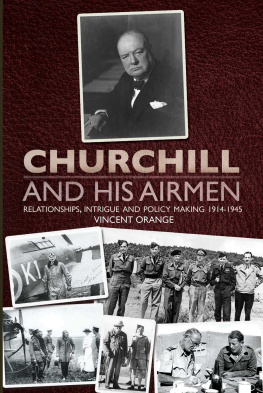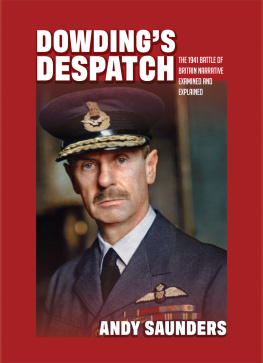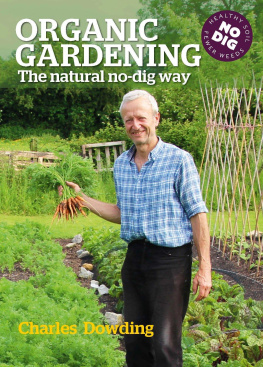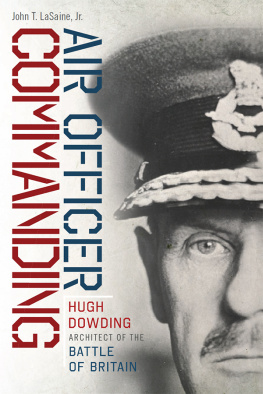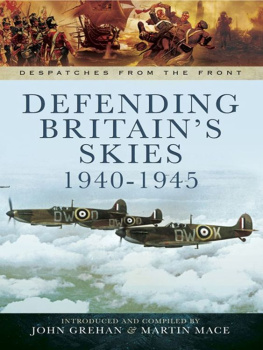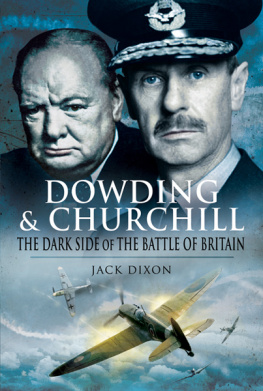
Published by
Grub Street Publishing
4 Rainham Close
London
SW11 6SS
Copyright Grub Street 2008
Copyright text Vincent Orange 2008
British Library Cataloguing in Publication Data
Orange, Vincent, 1935
Dowding of Fighter Command: victor of the Battle of Britain 1. Dowding, Hugh Caswall Tremenheere Dowding, Baron, 1882-1970 2. Great Britain. Royal Air Force History World War, 1939-1945 3. Marshals Great Britain Biography 4. Britain, Battle of, Great Britain, 1940 5. World War, 1939-1945 Aerial operations, British
I. Title
358.41331092
ISBN-13: 9781906502140
Digital Edition ISBN: 9781908117748
All rights reserved. No part of this publication may be reproduced, stored in a retrieval system, or transmitted in any form or by any means electronic, mechanical, photocopying, recording, or otherwise, without the prior permission of the copyright owner.
Typeset by Pearl Graphics, Hemel Hempstead
Printed and bound by MPG Ltd, Bodmin, Cornwall
Grub Street Publishing uses only FSC (Forest Stewardship Council) paper for its books.
Captions to back cover
Top: The Air Council in session at the Air Ministry 23 July 1940. Left to right: Air Vice-Marshal A. G. R. Garrod; Sir Harold G. Howitt; Air Marshal Sir Christopher L. Courtney (Air Member for Supply and Organisation); Air Marshal E. L. Gossage (Air Member for Personnel); Captain H. H. Balfour, M.P. (Under-Secretary of State for Air) (Vice-President of the Air Council); Rt. Hon. Sir Archibald Sinclair (Secretary of State for Air) (President of the Air Council); Air Marshal Sir Cyril Newall; Sir Arthur Street (Permanent Under-Secretary of State for Air); Air Chief Marshal Sir Wilfred R. Freeman (Air Member for Development and Production); Sir Charles Craven (Civil Member for Development and Production); Mr. R. H. Melville (Private Secretary to the Secretary of State for Air); Flight Lieutenant W. W. Wakefield, M.P. (Parliamentary Private Secretary to the Parliamentary Under-Secretary of State for Air).
Bottom: Dowding and his fighter boys, and girl. He is pictured with, left to right: S/L A.C. Bartley; W/C D.F.B Sheen; W/C I.R Gleed; W/C M.Aitken; W/C Sailor Malan; S/L A.C. Deere; F/O E.C. Henderson; F/L R.H. Hillary; W/C J.A. Kent; W/C C.F.B Kingcome; S/L D.H. Watkins; W/O R.H. Gretton.
for
AUDREY
in memory of her dear husband and my good friend and mentor
HENRY PROBERT
(1926-2007)
My job was to prevent the war from being lost,
not to win it, and when my job is done,
I shall go out like a cork from a bottle
Lord Dowding
Contents
Acknowledgements
Everyone who has written on any aspect of Royal Air Force history during the last thirty years owes a great deal to the former head of the Air Historical Branch, Air Commodore Henry Probert, who died on Christmas Day, 2007. Whenever I visited London, he found me space in the Branch, encouraged my efforts, introduced me to senior officers, arranged for me to speak at conferences and (best of all) he and his wife Audrey made me welcome in their home. He will always be a five-star gentleman for me.
I am also deeply indebted to Henrys successors: Sebastian Cox, Sebastian Ritchie, and all who toil in that ever-moving Branch not forgetting Humphrey Wynn, who escaped long ago. At the RAF Museum, Hendon, and the RAF College, Cranwell, everyone I met was kind and helpful, but I must mention Peter Elliott, Tim Pierce and Joel Hayward in particular. As always, I am grateful to archivists whom I do not know: at British National Archives in Kew, the Liddell Hart Centre in Kings College, London, Winchester College, and Georgetown University in Washington DC. One archivist whom I do know, and who has been a very helpful friend for years, is Yvonne Kinkaid, of Bolling Air Force Base, Washington, DC.
Paul Baillie, Elizabeth Hussey, Kevin Kelly, Simon Muggleton, Nick Peacock and Arnie Wilson in England were all helpful. For years now, I have benefitted from the expertise of all who work in the University of Canterbury Library: this time, I thank especially Janette Nicolle, Bronwyn Matthews and Katharine Samuel. My publisher, John Davies, gives me plenty of encouragement and Errol W. Martyn has again proved a tower of strength, especially in regard to providing First World War material. I am also grateful to Trevor Richards for his advice.
Without the wholehearted co-operation of David Whiting (Dowdings stepson), who sent me valuable information and photographs, this book would certainly be much poorer. But without the skills and tender loving care of my dear wife Sandra it would probably not have been completed and would certainly not have reached London by electronic means.
Vincent Orange,
Christchurch, New Zealand,
11 May 2008

From Moffat to Upavon, 1882-1914
Wiltshire Scotsman
His full name was Hugh Caswall Tremenheere Dowding. He was a Scotsman, born in the village of Moffat, about 50 miles south of Edinburgh, on 24 April 1882. His mother was also from southern England, but it can be argued that the boy was shaped by his first 13 years in Scotland. As a rule, we do not change much after that age, save to become a disappointment to ourselves and to those who know or even love us.
Moffat has a splendid statue of a ram, erected in 1875 and standing proudly on a rock, to honour the importance of sheep farming in the area. The image of that ram immovable, unwilling to back down from any challenge might also stand for Dowding. He would often have heard locals telling visitors that it has nae lugs; true, but it sees clearly, just as Dowding did throughout his long life as a soldier, airman and in his last 20 years as an influential opponent of cruelty to animals. It is likely, however, that Moffats famous Toffee Shop, an irresistible magnet for locals and visitors alike, appealed more to young Dowding if he was allowed to spend his pocket money there.
Whether we think Dowding was shaped more by rural Scotland than rural Wiltshire, he was certainly not an urban man: Whitehall was never, for him, a natural home, which may help us to understand why he was so often at odds with officers who were comfortable in its corridors of power. Moffat has a sulphur spring and some of that sulphur evidently got into young Hughs bloodstream because many of his colleagues especially those in high office would be shrivelled by him in later years. It was only when he was elderly and married for a second time that he became an amiable chap, easy to get along with.
John Dowding, Hughs great-grandfather, had a son, Benjamin, who He married Maria Caswall, daughter of a fellow-parson and grand-niece of a bishop. Hughs father, Arthur John Dowding (1855-1932), was one of their ten children. He was educated at Winchester College, as were several of Hughs forebears. One of Britains oldest public schools (founded by bishop William of Wykeham in 1382), it is spiritual home to countless Wykehamists who became famous in every walk of life and enjoy a reputation for being distinctive if not distinguished. Arthur was a good scholar, cricketer and athlete, cheerful and popular, who very properly became a prefect. He did well after Winchester, when he went up to New College, Oxford (also founded by bishop William, in 1379).
After brief spells of teaching in England, Arthur went to Fettes College in Edinburgh, one of Scotlands most famous schools. There he learned that wealthy local families regretted the lack of a nearby preparatory school run by gentlemen for their sons awaiting entry to Fettes. Arthur had class; they had money. So he agreed with a clergyman friend to set up a school dedicated to St Ninian that opened in Moffat in 1879. Ninian, who lived c. 360-432, was a significant choice as patron because it was he who began the endless task of converting the Scots to Christianity. He also built the first known stone church in Britain.
Next page

